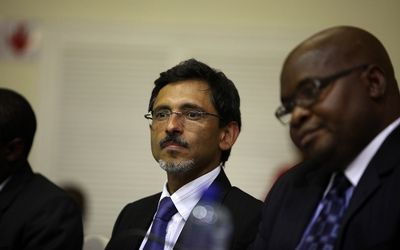A FINAL investment decision to establish a new steel mill will depend on the outcome of a prefeasibility study under way and a later feasibility study, Economic Development Minister Ebrahim Patel insists.
China’s Hebei Iron and Steel Group and the Industrial Development Corporation (IDC) agreed in September last year to undertake the prefeasibility study into the creation of a new low-cost steel plant. Also envisaged was a downstream industrial park to process some of the steel products into finished goods for domestic and export markets.
In a written reply on Tuesday to a parliamentary question by Democratic Alliance economic development spokesman Michael Cardo, Mr Patel differed from comments made earlier this year by IDC head of mining and metals Abel Malinga who insisted that "we are going ahead with it. We are not going to change our minds".
Mr Patel said that the envisaged $5bn plant would be funded partly with debt (up to 60%) and partly with equity (40%). The IDC would play a catalytical role in the establishment of the facility but would not to have a controlling stake in the project.
Mr Patel said the plant would have a design capacity of 5-million tons of steel per annum though consideration would be given during the detailed feasibility study to the option of undertaking the project in two phases of approximately 2.5-million tons each. An estimated 11,000 jobs would be created at the peak of construction which would span over at least 42 months whereas once operational about 3,500 workers would be employed.
• An earlier prefeasibility study was completed by the IDC in August 2012. This was based on the use of a rotary hearth furnace technology but this was abandoned as Hebei insisted that its participation was conditional on the use its blast furnace technology.
• Mr Patel noted that the primary advantage of the rotary hearth furnace technology, the most proven route worldwide for iron making, was that it did not require coking coal and therefore had the lowest operating cost. On the other hand its capital cost and electricity consumption were high.
Hebei’s blast furnace technology requires coking coal which is not available in SA which was why it was rejected as a first option in the first study.
Mr Patel said Hebei also wanted to increase the target size of the project to 5-million tons per annum, a substantial portion of which would be exported, to other sub-Saharan African markets.
Middelburg was originally considered as the best location for a rotary hearth furnace mill because of the availability of coal, raw material transport logistics, infrastructure including water, rail and electricity as well as proximity to inland domestic market. However, the need to import coking coal for a blast furnace steel mill put Middelburg at a competitive disadvantage and meant that coastal alternatives were being considered.
"The blast furnace process necessitates the use of coking coal that would need to be imported, possibly from Mozambique," Mr Patel said
Mr Patel said the new prefeasibility studies would assess the economic viability of blast furnace technology, the increased size of the mill and the project location. "Depending on the outcome of these additional prefeasibility studies, a detailed feasibility study will be conducted before a final investment decision is made," he noted.

Economic Development Minister Ebrahim Patel (centre). Picture: SUNDAY TIMES
A FINAL investment decision to establish a new steel mill will depend on the outcome of a prefeasibility study under way and a later feasibility study, Economic Development Minister Ebrahim Patel insists.
China’s Hebei Iron and Steel Group and the Industrial Development Corporation (IDC) agreed in September last year to undertake the prefeasibility study into the creation of a new low-cost steel plant. Also envisaged was a downstream industrial park to process some of the steel products into finished goods for domestic and export markets.
In a written reply on Tuesday to a parliamentary question by Democratic Alliance economic development spokesman Michael Cardo, Mr Patel differed from comments made earlier this year by IDC head of mining and metals Abel Malinga who insisted that "we are going ahead with it. We are not going to change our minds".
Mr Patel said that the envisaged $5bn plant would be funded partly with debt (up to 60%) and partly with equity (40%). The IDC would play a catalytical role in the establishment of the facility but would not to have a controlling stake in the project.
Mr Patel said the plant would have a design capacity of 5-million tons of steel per annum though consideration would be given during the detailed feasibility study to the option of undertaking the project in two phases of approximately 2.5-million tons each. An estimated 11,000 jobs would be created at the peak of construction which would span over at least 42 months whereas once operational about 3,500 workers would be employed.
• An earlier prefeasibility study was completed by the IDC in August 2012. This was based on the use of a rotary hearth furnace technology but this was abandoned as Hebei insisted that its participation was conditional on the use its blast furnace technology.
• Mr Patel noted that the primary advantage of the rotary hearth furnace technology, the most proven route worldwide for iron making, was that it did not require coking coal and therefore had the lowest operating cost. On the other hand its capital cost and electricity consumption were high.
Hebei’s blast furnace technology requires coking coal which is not available in SA which was why it was rejected as a first option in the first study.
Mr Patel said Hebei also wanted to increase the target size of the project to 5-million tons per annum, a substantial portion of which would be exported, to other sub-Saharan African markets.
Middelburg was originally considered as the best location for a rotary hearth furnace mill because of the availability of coal, raw material transport logistics, infrastructure including water, rail and electricity as well as proximity to inland domestic market. However, the need to import coking coal for a blast furnace steel mill put Middelburg at a competitive disadvantage and meant that coastal alternatives were being considered.
"The blast furnace process necessitates the use of coking coal that would need to be imported, possibly from Mozambique," Mr Patel said
Mr Patel said the new prefeasibility studies would assess the economic viability of blast furnace technology, the increased size of the mill and the project location. "Depending on the outcome of these additional prefeasibility studies, a detailed feasibility study will be conducted before a final investment decision is made," he noted.






















Change: 0.90%
Change: 0.89%
Change: 0.83%
Change: 0.79%
Change: 2.14%
Data supplied by Profile Data
Change: 0.00%
Change: 0.00%
Change: 0.90%
Change: 0.00%
Change: 0.00%
Data supplied by Profile Data
Change: -0.24%
Change: -0.04%
Change: -0.10%
Change: -0.16%
Change: -0.11%
Data supplied by Profile Data
Change: 0.00%
Change: 0.00%
Change: 0.00%
Change: 0.00%
Change: 0.00%
Data supplied by Profile Data